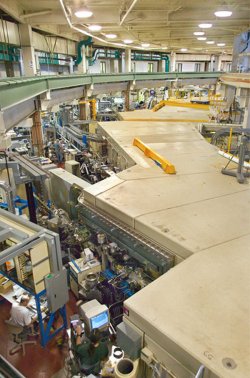Chemical & Materials Sciences Division
Research Highlights
February 2011
Shining Light into the Dark Places of Science
Howard Padmore discusses how to get better light sources for scientific discovery

An array of beamlines fan out from the storage ring (under concrete shielding) at the Advanced Light Source, a third-generation synchrotron and national user facility. Photo courtesy of ALS. Enlarge Image
The quality of light matters, whether creating photos of a group of people or a group of atoms. Dr. Howard Padmore from the Advanced Light Source (ALS) discussed how to create better light for scientific discoveries during his talk at the Frontiers in Chemical Imaging Seminar Series on January 13. This series, hosted by Pacific Northwest National Laboratory, features academic, government, and industrial leaders who discuss novel ideas and imaging advances.
Around the world, scientists use light sources to answer research questions in materials science, biology, chemistry, physics, and environmental sciences. These light sources use beams of x-ray, ultraviolet radiation, and infrared light.
The Lighted Road Ahead
Synchrotrons are one of the current generation of light sources, delivering beams with different wavelengths. For the next generation of light sources, Padmore discussed how scientists are investigating using free electron lasers (FELs). These lasers offer light that is 10 orders of magnitude brighter than current synchrotrons. However, the size and cost of FELs is formidable. "We are using materials physics to help improve FEL performance and reduce cost," said Padmore.
Getting More Electron Bang for Your Buck
Photocathodes play an important role in the design and structure of FELs. Their purpose is to produce electron bunches that are injected into the accelerator and used to produce the FEL beam. Padmore and his collaborators at ALS are working to optimize photocathodes in their quest for the next generation of light sources.
The ideal photocathode has a high quantum efficiency (QE), which in turn produces ultrashort light pulses within the FEL. Other desirable attributes include a short electron pulse, which is compact and speedy. The speed is measured as repetition rate. Today, there are a variety of candidate materials to improve photocathodes. Copper, for instance, has a short pulse and high repetition rate but a low QE.
But, are metals the best materials to use; what about layered compounds? A multialkali photocathode, using a combination of potassium, caesium, and antimony has the desired high QE under visible irradiation. In addition, photocathodes materials need to be chemically stable and durable under accelerator conditions. Photocathodes designed to support surface plasmons, small structures deposited on the cathode's surface, could produce high electron yields by enhancing the QE of robust materials such as silver. Another intriguing material is sliver, coated with a very thin magnesium oxide layer. The oxide layer can both increase the silver quantum yield and reduce the work function, or photon energy, needed to operate the photocathode.
Beams of Promise
"The development of efficient and productive photocathodes has implications not just for FELs, but for applications in the fields of catalysis and solar energy," said Dr. Wayne Hess, who manages PNNL's Chemical Physics and Analysis Group and leads research in the Chemical Imaging Initiative at PNNL. "Building the capabilities of light sources can provide researchers with powerful tools for state-of-the-art research."
About Howard Padmore: A Fellow of the Optical Society of America, Padmore is a Division Deputy for Experimental Systems at ALS, a third generation source of synchrotron x-rays located in Berkeley, California. He leads approximately 45 scientists and students in designing x-ray optical systems, operating 10 beamlines, and conducting research into materials and imaging. He has been actively involved in building the scientific program at the light source for nearly two decades in a diverse set of areas. His work is centered in developing high brightness photocathodes for FELs and manipulating plasmonic interactions in nanostructured materials. He has served on numerous scientific advisory committees in the United States and abroad.
